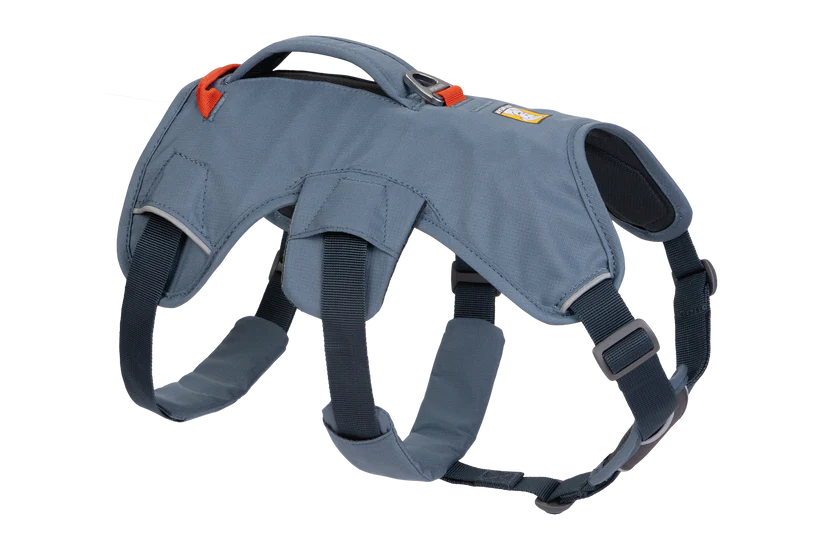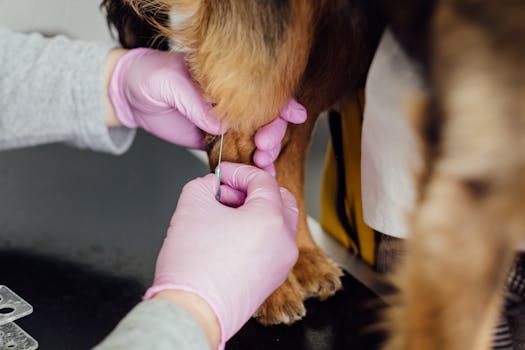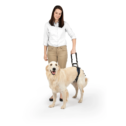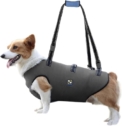Living with a canine companion facing mobility challenges can be both heartwarming and challenging.
Specialized dog harnesses have revolutionized how we support dogs with physical limitations, providing enhanced mobility, comfort, and independence. This comprehensive guide explores the world of adaptive harnesses, helping owners navigate the critical considerations for supporting their four-legged friends through various health conditions.
Our Top 3 Harness Types for Specific Mobility Challenges
- Front-Clip Support Harnesses
Front-clip support harnesses are engineered for dogs experiencing specific mobility challenges affecting their forward movement and balance.
PetSafe Deluxe Easy Walk No Pull Harness
These specialized designs provide critical support for dogs with partial rear leg weakness, neurological conditions, or coordination difficulties. By attaching near the chest, these harnesses offer enhanced control and stability, helping dogs maintain balance and navigate their environment more confidently. The strategic positioning allows owners to provide gentle guidance and support, reducing strain on the dog’s body while promoting more natural movement. Ideal for dogs recovering from injuries or managing chronic conditions that affect their locomotion.
- Rear-End Support Harnesses
Rear-end support harnesses are specifically designed to address challenges affecting a dog’s hind quarters. Conditions like hip dysplasia, degenerative myelopathy, and spinal cord issues can significantly impact a dog’s ability to move and maintain balance.
CareLift™ Rear Support Harness
These harnesses provide targeted support to the rear legs, helping dogs maintain mobility and independence. By lifting and supporting the hindquarters, they reduce strain on weakened muscles and joints, allowing for more comfortable movement. The design enables owners to assist their dogs during walking, climbing stairs, or getting up, providing a sense of security and improved quality of life for dogs with rear leg mobility challenges.
- Full-Body Lifting Harnesses
Full-body lifting harnesses represent the most comprehensive mobility assistance solution for dogs with significant physical limitations. These advanced harnesses provide complete support, distributing weight evenly and offering multiple lifting points to assist dogs with severe mobility challenges.
Coodeo Dog Lift Harness best Value
Ideal for dogs recovering from surgery, managing advanced neurological conditions, or experiencing total or partial paralysis, these harnesses enable owners to provide complete physical support. The design allows for safe transportation, assisted movement, and improved quality of life. Carefully engineered lifting mechanisms ensure comfort, prevent additional strain, and provide the maximum possible independence for dogs facing extensive mobility restrictions.
Understanding Special Needs in Canine Mobility
Mobility challenges in dogs can stem from numerous conditions:
Age-related Joint Degeneration
As dogs age, their joints naturally begin to deteriorate, leading to reduced mobility and increased discomfort. Conditions like arthritis can significantly impact a dog’s quality of life, causing pain and limiting movement. Senior dogs may experience gradual muscle weakness, reduced flexibility, and decreased stamina. Specialized harnesses provide crucial support during this stage, helping to distribute weight, reduce joint stress, and maintain the dog’s independence and ability to enjoy daily activities.
Neurological Disorders
Neurological conditions can profoundly affect a dog’s motor skills and overall mobility. Disorders such as intervertebral disc disease (IVDD), brain injuries, or progressive neurological conditions can cause weakness, lack of coordination, or partial paralysis. These challenges impact the dog’s ability to walk, balance, and perform basic movements. Adaptive harnesses become essential tools, offering support, stability, and confidence. They help dogs navigate their environment, provide owners with better control, and minimize the risk of further injury.
Orthopedic Injuries
Orthopedic injuries can result from accidents, sports activities, or underlying health conditions. Fractures, ligament tears, joint dislocations, and surgical interventions can temporarily or permanently impact a dog’s mobility. These injuries often require extended recovery periods and specialized support. Adaptive harnesses play a crucial role in rehabilitation, providing stability, reducing strain on injured areas, and supporting controlled movement. They help prevent further injury, assist in physical therapy, and promote healing by offering targeted support.
Congenital Disabilities
Some dogs are born with physical conditions that affect their mobility from birth. These may include limb deformities, spinal cord abnormalities, or genetic conditions that impact muscle strength and coordination.
Congenital disabilities can range from mild movement restrictions to more severe mobility challenges. Specialized harnesses designed for these conditions provide critical support, helping dogs develop strength, maintain balance, and navigate their environment. Early intervention with adaptive equipment can significantly improve a dog’s quality of life and ability to participate in daily activities.
Post-Surgical Recovery
Surgical procedures can leave dogs vulnerable and require careful management during recovery. Whether it’s orthopedic surgery, tumor removal, or neurological interventions, the post-surgical period demands gentle, supportive care.

Specialized harnesses aid in controlled movement, prevent strain on surgical sites, and provide owners with a secure method of assisting their dog. They help manage pain, support gradual rehabilitation, and reduce the risk of complications. The right harness can make a significant difference in recovery speed and overall healing process.
Chronic Health Conditions
Chronic health conditions like degenerative myelopathy, muscular dystrophy, or progressive neurological diseases can gradually impact a dog’s mobility. These long-term conditions require adaptive strategies to maintain the dog’s quality of life. Specialized harnesses become essential tools in managing these challenges, offering support that evolves with the dog’s changing needs.
They help maintain independence, provide physical support, and give owners a practical method of assistance. By addressing mobility limitations proactively, dogs can continue to enjoy meaningful interactions and experiences.
Key Features of Specialized Support Harnesses
Adaptive Design Elements: Support Systems
Comprehensive support systems in dog harnesses represent a holistic approach to mobility assistance.
These advanced designs go beyond simple restraint, creating a complete support network that addresses multiple physical challenges.
By distributing weight evenly across the dog’s body, these harnesses minimize stress on any single point, reducing pain and potential further injury. The multiple lifting points allow for precise control and support, enabling owners to assist their companions with greater confidence and ease. Innovative engineering considers the unique biomechanics of canine movement, creating solutions that adapt to individual dogs’ specific needs.
Material Considerations
The selection of materials in specialized dog harnesses is a critical aspect of their effectiveness. Lightweight, breathable fabrics ensure comfort while preventing overheating and skin irritation.
Modern adaptive harnesses utilize advanced textile technologies that combine durability with flexibility, allowing for natural movement while providing robust support. Padded contact areas are strategically designed to reduce pressure points and prevent chafing, particularly important for dogs with sensitive skin or those experiencing prolonged harness use. The materials must withstand frequent use, washing, and varying environmental conditions while maintaining their supportive properties and aesthetic appeal.
Ergonomic Support Principles
Ergonomic design in dog support harnesses represents a sophisticated approach to mobility assistance. These principles focus on creating a natural, comfortable experience that mimics the dog’s natural movement patterns.

By carefully analyzing canine biomechanics, designers develop harnesses that provide support without restricting movement or causing additional stress. The goal is to create a seamless extension of the dog’s body, offering assistance that feels intuitive and comfortable. Considerations include weight distribution, pressure point reduction, and adaptability to different body shapes and sizes, ensuring that each dog receives personalized, effective support.
Condition-Specific Harness Recommendations
Partial Paralysis Support
Partial paralysis presents unique challenges in canine mobility, requiring specialized support solutions that address individual needs. Harnesses designed for this condition feature strategic lifting points, adjustable configurations, and targeted support mechanisms.
They help dogs maintain dignity and mobility by providing assistive technology that compensates for muscular weakness or nerve damage. The design allows for controlled movement, reduces the risk of further injury, and gives owners a practical method of providing physical assistance. Advanced materials and innovative engineering ensure these harnesses offer both functional support and comfort.
Three-Legged Dog Assistance
Dogs with limb differences require specialized mobility solutions that provide balanced support and accommodate their unique movement patterns. Harnesses designed for three-legged dogs focus on redistributing weight, preventing additional strain, and promoting confidence.

These adaptive designs feature asymmetrical support systems that help compensate for the missing limb, ensuring stable and comfortable movement. By providing targeted assistance, these harnesses enable dogs to maintain an active lifestyle, reduce compensatory injuries, and support their natural adaptation to their physical condition. The goal is to create a supportive solution that feels natural and empowering.
Neurological Condition Management
Neurological conditions can significantly impact a dog’s mobility, requiring sophisticated support solutions. Specialized harnesses for neurological challenges incorporate advanced stabilization features that address balance, coordination, and movement difficulties.
These designs provide gentle yet firm support, helping dogs navigate movement challenges caused by conditions like vestibular disorders, spinal cord issues, or brain injuries. The harnesses offer multiple points of contact, allowing owners to provide precise assistance and prevent falls. Adaptive technologies and carefully engineered support mechanisms help dogs maintain independence and quality of life despite neurological limitations.
Geriatric Canine Support
Geriatric dogs require gentle, low-impact mobility solutions that respect their changing physical needs. Specialized harnesses designed for senior dogs focus on providing soft, adaptable support that minimizes stress and maximizes comfort. These designs consider the reduced muscle mass, potential joint sensitivity, and decreased stamina typical of aging dogs. Features include extra padding, lightweight materials, and easy-to-use configurations that make daily activities more manageable.
The harnesses help senior dogs maintain their independence, continue enjoying walks and interactions, and provide owners with a practical method of offering physical support during their companion’s golden years.
Selecting the Perfect Supportive Harness
Critical Assessment Factors
- Precise Measurement: Accurate harness sizing is crucial for a dog’s comfort and mobility. Incorrect measurements can lead to chafing, restricted movement, or ineffective support. Proper sizing ensures the harness provides optimal assistance without causing additional stress or discomfort to the dog’s body.
- Condition-Specific Considerations: Each dog’s mobility challenge requires a unique approach. Veterinarian insights, current mobility levels, and potential future changes must be carefully evaluated. The perfect harness adapts to the dog’s specific condition, providing targeted support that evolves with their changing needs.
Measurement Guide Essentials
- Measure chest circumference to ensure proper fit
- Check weight distribution points for balanced support
- Assess range of motion to prevent movement restrictions
- Consider potential growth or condition progression
Innovative Specialized Harnesses
Medical-Grade Harness
Leading manufacturers collaborate with veterinary professionals to develop scientifically researched harness technologies. These brands focus on creating adaptive solutions that meet strict medical standards, offering evidence-based support for dogs with various mobility challenges.
Specialized Mobility Equipment
Cutting-edge mobility equipment manufacturers push the boundaries of adaptive design. They offer customizable options, advanced material technologies, and comprehensive support configurations that address the most complex canine mobility needs.
Complementary Mobility Support Strategies
Adaptive Equipment Ecosystem
Supplementary Mobility Aids
Beyond harnesses, a range of adaptive equipment supports dogs with mobility challenges. Wheelchairs, orthopedic beds, and home modification accessories create a comprehensive support system that enhances a dog’s quality of life and independence.
Maintenance and Care
Proper harness maintenance ensures continued effectiveness and hygiene. Regular inspections, thorough cleaning, and timely replacements are crucial. This approach maintains the harness’s supportive qualities and prevents potential issues from wear and tear.
Holistic Approach to Special Needs Support
Beyond Physical Assistance
- Emotional Well-Being
Mobility challenges impact a dog’s mental state. Positive reinforcement, confidence-building techniques, and mental stimulation are essential. The goal is to support not just physical movement, but the dog’s overall emotional health and happiness.
- Owner Support Resources
Caring for a dog with mobility challenges can be overwhelming. Support groups, online communities, and professional counseling provide crucial emotional and practical support for owners navigating this challenging journey.
Professional Consultation Insights
Collaborative Care Approach
- Expert Consultation Network: A multidisciplinary approach involves veterinary specialists, canine physical therapists, rehabilitation professionals, and mobility equipment experts. This collaborative network ensures comprehensive, personalized care for dogs with special mobility needs.
- Ongoing Assessment Strategies: Mobility support is not a one-time solution. Regular health evaluations, adaptive equipment adjustments, and comprehensive care planning ensure the dog receives optimal support throughout their changing health journey.
Final Thoughts
Specialized harnesses represent more than just mobility equipment—they’re tools of empowerment, dignity, and continued quality of life. By understanding individual needs, selecting appropriate support, and maintaining a holistic approach, owners can help their canine companions thrive despite physical challenges.










